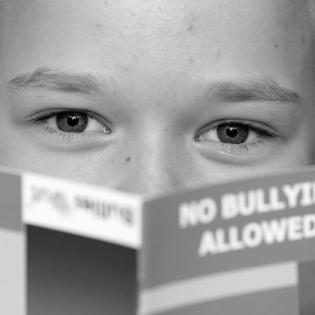Buckets of Kindness
Learners role-play responses to bullying behavior and start to brainstorm ways to promote kind behaviors at school and decrease bullying behaviors.
The learners will:
- describe the different ways people respond to bullying behaviors.
- define bullying, bully, victim, and bystander.
- compare bullying behavior to other hurtful situations.
- propose creative ways to stop bullying and unkind behaviors.
- a bucket or similar container
- paper hearts or any objects that can be added to the bucket to represent kind acts
- bullying: repeated teasing, hurting, or scaring of someone who seems different
- bully: a person who likes to tease, hurt, or scare people. A bully often picks on someone who seems different from themselves.
- bystander: a person who is present at the action but isn't involved or isn't one of the main participants
- philanthropy: giving time, talent, or treasure and taking action for the common good
- responsibility: the task one is trusted to perform;
- victim: a person cheated, fooled, or harmed by another
Students have a discussion at home about ways to prompt kids in the whole school to do kind things for one another.
Students make no-bullying posters and display them around school.
Henkes, Kevin. Chrysanthemum. Mulberry Books, 1996. ISBN-13: 978-0688147327
McCloud, Carol. Have You Filled a Bucket Today? A Guide for Daily Happiness for Kids. Ferne Press, 2006. ISBN-13: 978-0978507510
Instructions
Anticipatory Set:
Read aloud the book Have you Filled a Bucket Today? A Guide for Daily Happiness for Kids by Carol McCloud. Or share this YouTube readaloud version. This book illustrates the concept that we all carry around an invisible bucket that contains the good things that people say and do. When something negative happens, we dip from our buckets. The story encourages young people to fill one anothers' buckets with kindness. Talk about actions that make us and others feel good about ourselves. Ask how having full buckets makes the whole school a better place.
Use a prop of a bucket and cut-out paper hearts on hand to illustrate the concepts from the book.
Tell the students that bullying behavior takes good things out of our buckets and affects the whole school.
Say, "A person who bullies never acts alone." Tell the class that there are always at least three people there: the bully, the victim, and the bystander. The bystander is the person who watches the behavior. Discuss that a bystander has a choice to stand up for the victim. Make sure the students understand that doing nothing or encouraging the bullying behavior may create bad feelings. The bystander can do something kind to fill back up the victim's bucket.
The bystander has some choices at the time of the bullying behavior:
- to ignore the problem (takes kindness out of the bucket)
- to help the victim (puts kindness into the bucket)
- to tell an adult (puts kindness into the bucket)
- or to encourage the bully (takes kindness out of the bucket)
Share these examples of the above choices of a bystander. Ask students to say whether they are helping or hurting the victim.
- Bystander says, "Cut it out; that's not funny." (help the victim)
- Bystander says, "I'm telling a teacher what you are doing." (tell an adult)
- Bystander says, "Yeah, I think his hair looks funny, too." (continue the bullying)
- Bystander says, "Whatever." (ignore the problem)
- Bystander says, "I really like your hair. Let's go play tetherball." (support the victim)
Say, "Did you know that if one person watching a bullying situation says 'Stop it!' many times the bullying will stop? This can be hard to do, but it's important to try. When you stand by and do nothing, that's saying that bullying is okay with you." Tell students that bystanders can make a big difference in helping to stop bullying behavior.
Say, "The victim has some choices too." Tell the class that victims of bullying can walk away when the bully gets near, ignore a bully's mean words, say something nice to the bully, or yell STOP!
Talk about which responses they think will work for a victim to use to stop a bully.
Tell the students that bullying is bad for everyone. No one feels safe when bullying is allowed. Even the bullying person doesn't feel good about his or her behavior.
Ask the students to think of ways they can teach everyone in the school about bullying and filling each other's buckets. Start a brainstorming list and ask students to get more ideas from their families tonight.
Philanthropy Framework
-
Strand PHIL.I Definitions of Philanthropy
-
Standard DP 01. Define Philanthropy
-
Benchmark E.3 Recognize that citizens have a responsibility for the common good as defined by democratic principles.
-
-
-
Strand PHIL.II Philanthropy and Civil Society
-
Standard PCS 01. Self, citizenship, and society
-
Benchmark E.1 Define the word <em>trust</em> and its role in all communities.
-
Benchmark E.3 Describe a benefit of group cooperation.
-
Benchmark E.4 Describe the characteristics of someone who helps others.
-
-
Standard PCS 02. Diverse Cultures
-
Benchmark E.2 Discuss the importance of respect for others.
-
Benchmark E.4 Demonstrate listening skills.
-
Benchmark E.5 Identify the relationship between individual rights and community responsibility.
-
-
-
Strand PHIL.III Philanthropy and the Individual
-
Standard PI 01. Reasons for Individual Philanthropy
-
Benchmark E.1 Describe one reason why a person might give or volunteer.
-
Benchmark E.5 Give examples of actions students can take to improve the common good and list or describe responsibilities that go with those actions.
-
-
